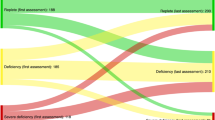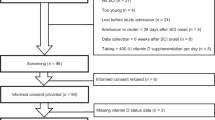Abstract
Study design:
This is a retrospective analysis of total serum 25-hydroxyvitamin D (25[OH]D) in Swiss elite wheelchair athletes.
Objectives:
The aim was to investigate the occurrence of vitamin D deficiency in Swiss elite wheelchair athletes over the whole year and to detect differences between winter and summer months, and between indoor and outdoor athletes.
Setting:
This study was conducted in Switzerland.
Methods:
A total of 164 blood samples from 72 Swiss elite wheelchair athletes (mean±s.d.: age 32±13 years) were analyzed for total serum 25[OH]D. All participants were members of the national team in their discipline. The following disciplines have been included: rugby, athletics, cycling, tennis, ski alpine, curling and basketball. According to general guidelines, insufficient vitamin D status was defined between 50 and 75 nmol l−1, deficiency below 50 nmol l−1 and severe deficiency below 27.5 nmol l−1.
Results:
In all, 73.2% of all samples showed an insufficiency/deficiency in vitamin D status. Total serum 25[OH]D was significantly higher during summer compared with winter months (69.5±21.4 nmol l−1 vs 51.5±21.9 nmol l−1; P<0.001). Indoor sports showed a higher amount of vitamin D insufficiency/deficiency (80.9%) than outdoor sports (70.1%), with a significantly higher 25[OH]D concentration in outdoor sports (P=0.042).
Conclusion:
A high percentage of vitamin D deficiency was found among Swiss elite wheelchair athletes. Conclusively, we recommend supplementation with vitamin D—especially during winter—to prevent a deficiency and an impairment of performance.
Similar content being viewed by others
Log in or create a free account to read this content
Gain free access to this article, as well as selected content from this journal and more on nature.com
or
References
Carroll A, Onwuneme C, McKenna MJ, Mayne PD, Molloy EJ, Murphy NP . Vitamin D status in Irish children and adolescents: value of fortification and supplementation. Clin Pediatr (Phila) 2014; 53: 1345–1351.
Flood-Nichols SK, Tinnemore D, Huang RR, Napolitano PG, Ippolito DL . Vitamin D deficiency in early pregnancy. PLoS ONE 2015; 10: e0123763.
Bruyere O, Cavalier E, Souberbielle JC, Bischoff-Ferrari HA, Beaudart C, Buckinx F et al. Effects of vitamin D in the elderly population: current status and perspectives. Arch Public Health 2014; 72: 32.
Bauman WA, Zhong YG, Schwartz E . Vitamin D deficiency in veterans with chronic spinal cord injury. Metabolism 1995; 44: 1612–1616.
Nemunaitis GA, Mejia M, Nagy JA, Johnson T, Chae J, Roach MJ . A descriptive study on vitamin D levels in individuals with spinal cord injury in an acute inpatient rehabilitation setting. PM R 2010; 2: 202–208.
Zhou XJ, Vaziri ND, Segal JL, Winer RL, Eltorai I, Brunnemann SR . Effects of chronic spinal cord injury and pressure ulcer on 25(OH)-vitamin D levels. J Am Paraplegia Soc 1993; 16: 9–13.
Vieth Streym S, Kristine Moller U, Rejnmark L, Heickendorff L, Mosekilde L, Vestergaard P . Maternal and infant vitamin D status during the first 9 months of infant life-a cohort study. Eur J Clin Nutr 2013; 67: 1022–1028.
Bartoszewska M, Kamboj M, Patel DR . Vitamin D, muscle function, and exercise performance. Pediatr Clin North Am 2010; 57: 849–861.
Jaaskelainen T, Knekt P, Suvisaari J, Mannisto S, Partonen T, Saaksjarvi K et al. Higher serum 25-hydroxyvitamin D concentrations are related to a reduced risk of depression. Br J Nutr 2015; 113: 1418–1426.
Jaddou HY, Batieha AM, Khader YS, Kanaan SH, El-Khateeb MS, Ajlouni KM . Depression is associated with low levels of 25-hydroxyvitamin D among Jordanian adults: results from a national population survey. Eur Arch Psychiatry Clin Neurosci 2012; 262: 321–327.
Szabo A . Skeletal and extra-skeletal consequences of vitamin D deficiency. Orv Hetil 2011; 152: 1312–1319.
Mandarino NR, Junior F, Salgado JV, Lages JS, Filho NS . Is vitamin D deficiency a new risk factor for cardiovascular disease? Open Cardiovasc Med J 2015; 9: 40–49.
Beveridge LA, Witham MD . Controversy in the link between vitamin D supplementation and hypertension. Expert Rev Cardiovasc Ther 2015; 13: 1–3.
Annweiler C, Rolland Y, Schott AM, Blain H, Vellas B, Herrmann FR et al. Higher vitamin D dietary intake is associated with lower risk of Alzheimer's disease: a 7-year follow-up. J Gerontol A Biol Sci Med Sci 2012; 67: 1205–1211.
Berridge MJ . Vitamin D cell signalling in health and disease. Biochem Biophys Res Commun 2015; 460: 53–71.
Wong G, Lim WH, Lewis J, Craig JC, Turner R, Zhu K et al. Vitamin D and cancer mortality in elderly women. BMC Cancer 2015; 15: 106.
Kim KJ, Kim YJ, Kim SH, An JH, Yoo HJ, Kim HY et al. Vitamin D status and associated metabolic risk factors among North Korean refugees in South Korea: a cross-sectional study. BMJ Open 2015; 5: e009140.
Tsugawa N . Bone and Nutrition. Vitamin D intake and bone. Clinical calcium 2015; 25: 973–981.
Ceglia L, Harris SS . Vitamin D and its role in skeletal muscle. Calcif Tissue Int 2013; 92: 151–162.
Cannell JJ, Hollis BW, Sorenson MB, Taft TN, Anderson JJ . Athletic performance and vitamin D. Med Sci Sports Exerc 2009; 41: 1102–1110.
Farrokhyar F, Tabasinejad R, Dao D, Peterson D, Ayeni OR, Hadioonzadeh R et al. Prevalence of vitamin D inadequacy in athletes: a systematic-review and meta-analysis. Sports Med 2015; 45: 365–378.
Bischoff-Ferrari HA, Dawson-Hughes B, Willett WC, Staehelin HB, Bazemore MG, Zee RY et al. Effect of Vitamin D on falls: a meta-analysis. JAMA 2004; 291: 1999–2006.
Ward KA, Das G, Berry JL, Roberts SA, Rawer R, Adams JE et al. Vitamin D status and muscle function in post-menarchal adolescent girls. J Clin Endocrinol Metab 2009; 94: 559–563.
Magee PJ, Pourshahidi LK, Wallace JM, Cleary J, Conway J, Harney E et al. Vitamin D status and supplementation in elite Irish athletes. Int J Sport Nutr Exerc Metab 2013; 23: 441–448.
Vieth R . Why the minimum desirable serum 25-hydroxyvitamin D level should be 75 nmolL−1 (30 ngml−1. Best Pract Res Clin Endocrinol Metab 2011; 25: 681–691.
World Medical Association Inc.. Declaration of Helsinki. Ethical principles for medical research involving human subjects. J Indian Med Assoc 2009; 107: 403–405.
Burnand B, Sloutskis D, Gianoli F, Cornuz J, Rickenbach M, Paccaud F et al. Serum 25-hydroxyvitamin D: distribution and determinants in the Swiss population. Am J Clin Nutr 1992; 56: 537–542.
Merlo C, Trummler M, Essig S, Zeller A . Vitamin D deficiency in unselected patients from swiss primary care: a cross-sectional study in two seasons. PLoS ONE 2015; 10: e0138613.
Halliday TM, Peterson NJ, Thomas JJ, Kleppinger K, Hollis BW, Larson-Meyer DE . Vitamin D status relative to diet, lifestyle, injury, and illness in college athletes. Med Sci Sports Exerc 2011; 43: 335–343.
Lehtonen-Veromaa M, Mottonen T, Irjala K, Karkkainen M, Lamberg-Allardt C, Hakola P et al. Vitamin D intake is low and hypovitaminosis D common in healthy 9- to 15-year-old Finnish girls. Eur J Clin Nutr 1999; 53: 746–751.
Acknowledgements
We thank Ruth Heller, Seline Magron and Eliane Arnold-Küng from the Institute of Sports Medicine Nottwil, Switzerland for their help with blood sampling and the laboratory of the Swiss Paraplegic Centre Nottwil for vitamin D analysis.
Author information
Authors and Affiliations
Corresponding author
Ethics declarations
Competing interests
The authors declare no conflict of interest.
Rights and permissions
About this article
Cite this article
Flueck, J., Hartmann, K., Strupler, M. et al. Vitamin D deficiency in Swiss elite wheelchair athletes. Spinal Cord 54, 991–995 (2016). https://doi.org/10.1038/sc.2016.33
Received:
Revised:
Accepted:
Published:
Issue date:
DOI: https://doi.org/10.1038/sc.2016.33
This article is cited by
-
Independent association of hypovitaminosis d with non-alcoholic fatty liver disease in people with chronic spinal cord injury: a cross-sectional study
Journal of Endocrinological Investigation (2023)
-
Vitamin-D-Supplementierung im Sport: Was sind die aktuellen Empfehlungen?
Journal für Gynäkologische Endokrinologie/Schweiz (2021)
-
Vitamin D and the Athlete: Current Perspectives and New Challenges
Sports Medicine (2018)



